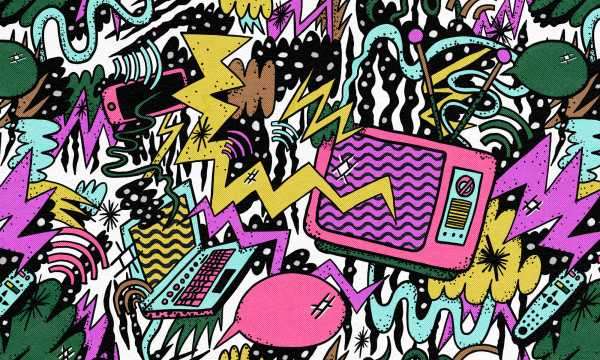
Share this story
-
Share this on Facebook
-
Share this on Twitter
-
Share
All sharing options
Share
All sharing options for:
Can monoculture survive the algorithm?
-
Reddit
-
Pocket
-
Flipboard
-
Email
This story is part of a group of stories called
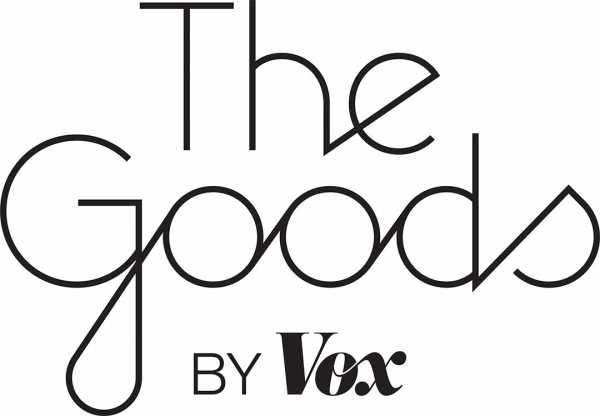
Big Endings
The past year has felt like a peak in mega-budget world-spanning media spectacles that command our attention, one outrageous finale after another. On April 26, 2019, the film Avengers: Endgame was released in the United States. Less an original narrative than an accretion of capital, technology, and celebrity, it had a budget of $356 million.
By July, the movie — the closing of a phase in the vast Marvel Cinematic Universe — was the highest-grossing movie in the history of Hollywood; it has so far achieved a global box office of around $2.8 billion. A month later, on May 19, the final episode of Game of Thrones aired on HBO, the end of an eight-season run that began in 2011. 19.3 million people watched the episode, a record for the series. The latest Star Wars film will cap off the franchise’s third trilogy on December 20 and attract millions more viewers. But it’s not just the stories that are ending.
Two Concerns
This communal moment of mass culture has occasioned celebration as well as a bout of anxiety. We’re in the midst of the Streaming Wars, with so many different media products and platforms competing for our attention — Netflix, Hulu, Amazon, Disney+, AppleTV+, and the still-to-come Peacock and HBO Max, to name but a few. Journalists and critics are worried that the huge popularity and sense of universality that Avengers and Game of Thrones achieved are now disappearing for good. The word often used to describe these omnipresent mass-entertainment products is “monoculture.”
The Ringer eulogized Game of Thrones as “the very last piece of TV monoculture” and Vulture “the last show we watch together.” “Monoculture is dead, or will die with Game of Thrones,” according to Lainey Gossip’s Elaine Lui. Now, “we watch what we like, and we cluster together with the people who also watch what we like.” Even the era of extensive recaps was pronounced over, if not the reign of prestige TV itself. We live in a “time of cultural fragmentation,” wrote Alex Shephard in the New Republic, arguing that not even the Nobel Prize for literature has survived as a representation of monoculture.
Within the monoculture obsession, there are two concerns. The first is that in the digital streaming era we have lost a perceived ability to connect over media products as reference points that everyone knows, the way that we used to discuss the weather or politics, at least in a bygone time before our realities were split by climate change and Fox News. The fear is that we exist in a fragmented realm of impenetrable niches and subcultures enabled by streaming media.
The second concern is that, because of the pressures of social media and the self-reinforcing biases of recommendation algorithms that drive streaming, culture is becoming more similar than different. We are worried that our digital niches cause a degree of homogenization, which the word monoculture is also used to describe.
“If Twitter controls publishing, we’ll soon enter a dreary monoculture that admits no book unless it has been prejudged and meets the standards of the censors,” Jennifer Senior wrote in a New York Times opinion piece about young-adult literature. Mass media has “been getting more mass,” wrote Farhad Manjoo, also in the Times, responding to the popularity of Lil Nas X’s “Old Town Road,” which went from a TikTok meme to one of the most popular pop songs ever made, at least according to its time on the charts.
“Despite the barrage of choice, more of us are enjoying more of the same songs, movies and TV shows,” Manjoo continued. The effect is happening across different cultural industries: “We’re returning to a media monoculture,” made up of corporatized, homogenized websites instead of smaller blogs, Darcie Wilder wrote on the Outline. Martin Scorsese echoed the complaint when he argued that Marvel movies “aren’t cinema” but instead bland, market-tested products without artistic integrity.
These two concerns appear in some ways irreconcilable, and yet they coexist. Is there less monoculture today, or is culture more mass than ever? Are we siloed within our own preferences or are we unable to escape the homogenized net-average, consuming all the same things?
The debate over monoculture seems to be less about our inherent desire for CGI dragons or superheroes than human connection and recognition — the assuaging of some existential loneliness induced by the internet. With streaming platforms like Netflix or Spotify, you never really know how many people are watching, hearing, or following the same things you are, so you’re never sure which media experiences are shared in common and which are not. That leaves us consumers feeling adrift.
I. FRAGMENTATION
The Meaning of Monoculture
Monoculture is more a messy symbol than an exact term. The Latin root “cultura” means cultivation. Monoculture in a scientific sense is an “area of farm land on which only one crop is grown or one type of animal is kept.” Much of industrialized farming is monoculture: think vast stretches of corn or wheat, or the undifferentiated green of a suburban lawn.

Monoculture might be efficient as far as agricultural output, but it’s also dangerous, decreasing diversity, depleting soil, and using more water than varied fields. By the early 19th century, “culture” moved from referring to plants to the cultivation of learning and taste, and by the 20th century it described the “collective customs and achievements of a people.”
Today, the word monoculture is used to describe a monolithic culture: the range of artifacts, characters, voices, and stories that a specific demographic — Americans, for example — find recognizable and relatable. But the word also evokes a homogenized space, a Monocultural Cinematic Universe in which everything is bright, vapid, and family-friendly, and any whimpering of dissent is smoothed over into sameness: monotonous culture.
What Was the Monoculture?
The monoculture seems to refer to some ill-defined age of universality made up of everything from Johnny Carson hosting the Tonight Show to Friends, Seinfeld, and The Office — the 20th-century aegis of white, middlebrow American entertainment, usually starring white Americans. This was also the ascendant era of broadcast media in radio, film, and linear television (the term for cable and network TV that isn’t on-demand). Industry gatekeepers made top-down decisions about what content would be made and when it would be shown, resulting in a lack of diversity that is only now beginning to change.
Monoculture is a Pleasantville image of a lost togetherness that was maybe just an illusion in the first place, or a byproduct of socioeconomic hegemony. It wasn’t that everyone wanted to watch primetime Seinfeld, but that’s what was on, and it became universal by default.
Digital Monoculture
We are in the midst of determining if the kind of monoculture that thrived during the broadcast era can exist when many forms of media are opt-in: we can watch whatever we want, when we want. The “digital monoculture” could refer to the array of popular, recognizable reference points that have arisen and are accessed through the on-demand internet, whether it’s Game of Thrones or “Baby Shark.”
The universality that monoculture entails is valuable, because what everyone already knows is what they are likely to keep consuming — hence the overwhelming popularity of reboots and sequels. It’s also why Netflix paid $100 million in 2018 to keep Friends on its platform for another year (WarnerMedia later outbid Netflix, $85 million a year for five years, to put the show on HBO Max).
Big-budget productions try to worm material into the now-fragmented monocultural framework by manufacturing new universal reference points, as The Mandalorian has with its insta-meme Baby Yoda. Piggybacking on old monoculture is less risky than starting from scratch. The most successful example of digital-native monoculture might be Netflix’s Stranger Things, which merited the iconic public display of billboards in Times Square (not coincidentally, it’s also a show that references decades of pop culture).
Businesses turn their own intellectual property into self-reproducing mini-monocultures because monopolies are easiest to monetize. The streaming platforms and their various signature franchises form walled gardens, a metaphor that also recalls the scientific definition of monoculture: nothing else is allowed to grow there; there is no cross-pollination. Surely the monoculture isn’t quite dead if Netflix viewers have consumed a net 500 million hours of Adam Sandler movies.
Watching Together
More than a sheer volume of viewers, what monoculture entails is a feeling. Linear TV gave us a monocultural feeling because we knew millions, tens of millions, of other people were watching the same channel as us at the same time, though we couldn’t see them. While tuned in we felt connected to the “grid of 200 million,” the social community of American TV watchers that George W.S. Trow observed in his 1980 essay on television, Within the Context of No Context. (Social media is our new grid, and its fervent fandoms in part a response to the desire for more communal experience.)
More than a sheer volume of viewers, what monoculture entails is a feeling.
Streaming television lacks much of that feeling because it is on-demand and because the platforms are pointedly opaque about their metrics for the sake of protecting their business models. (Nielsen ratings, which publicly measure linear TV audiences, are only just starting to cover streaming services.)
The only way of knowing how many other people are consuming the latest season of Bojack Horseman at the same time you are is to check some other part of the internet, like searching a show’s hashtag on Twitter. This kind of asynchronicity is particularly deadly for talk shows, which Netflix has been struggling to produce. Maybe the format was optimized for linear TV, sparking watercooler chat that you didn’t have to preface with the streaming-era refrain, “Are you watching _______?” The answer is rarely yes.
Streaming “forces a little bit more evangelism,” investor Hunter Walk told me. Walk is the co-founder of the venture-capital firm Homebrew, which invests in digital platforms, and a commentator on new-media consumption habits. “If you’re watching something early or first, you’re going to be the carrier of that to your friends.” The feeling digital media induces is, “‘It’s my job to get them to watch it so we can talk about it,’” he continued. We all become the programming head of our own virtual TV network, deciding what gets airtime and what doesn’t.
If monoculture depends on this feeling of watching together, then streaming makes it more difficult to establish, because we watch different things at different paces for different reasons. Though widespread popularity is clearly still possible, there’s a newfound distinction between media’s content — its subject matter — and its context — the social environment, or lack thereof, in which we consume it. Certain shows rely on generating a public discourse while others thrive without it, or find fans only in an online niche. As Walk put it: “Some things you watch just because your friends are watching it; some things you watch even if your friends aren’t watching it. I don’t give a shit what my friends think about Westworld. I need the sub-Reddit that’s going to unpack the foreshadowing.”
Monoculture is a subjective, shifting frame of reference, not a default reality. Walk’s points underline how we now create our own communities around consuming and discussing particular media. On Twitter, I feel like Succession has fully saturated the discourse and become inescapable, but elsewhere, linear TV’s This Is Us is the height of popularity.
At its peak after the 2018 Super Bowl, This Is Us had some 27 million viewers in one day, while Succession only hit one million during its recent season-two finale. A show about mean rich people isn’t exactly universal, but it gets talked about more intensely in certain media-dense environments and thus takes on the aspects of active monoculture, where This Is Us has faded in coverage from magazines and entertainment websites, though many more people watch it.
A Chart of Digital Media Consumption
When we talk about monoculture, it usually includes content that is widely consumed, and socially consumed. We could arrange various modes of digital media consumption on a chart, with a horizontal axis of the scale at which the content was designed to exist (trying to appeal to many people, or a smaller group?) and a vertical axis of the context in which the content is consumed (do you actively discuss it with others, or watch it privately?). We can fill it in with a few linear and streaming TV shows:
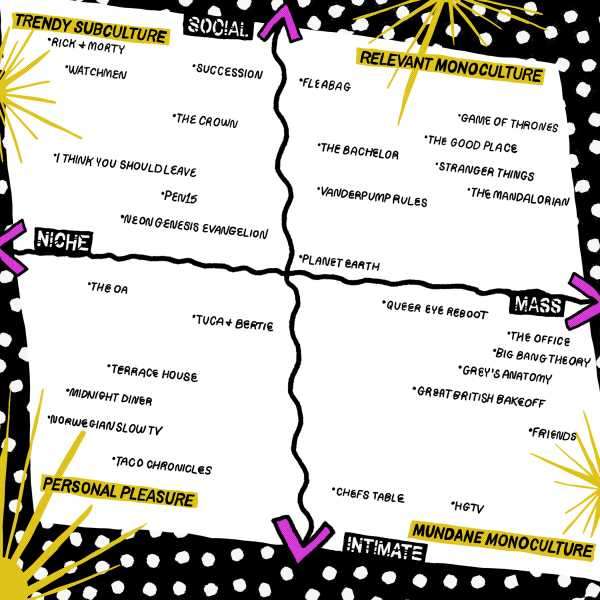
In the top-right corner, Social-Mass, is the relevant monoculture, the stuff that is actively creating its own communities of interest and public discussion. In the lower-right, Intimate-Mass represents the mundane monoculture, the productions that are already familiar comforts. The top-left is the first draft of monoculture, the Social-Niche content that a smaller demographic of advance tastemakers pore over intensely. The bottom-left is content consumed predominantly as a personal pleasure, which might never make it into the public sphere.
Shows and movies (or any cultural products) can move across the categories over time, and exist on a spectrum of points between them. Fleabag, for example, had a gradual movement from Intimate-Niche to Social-Niche to Social-Mass — the hot-priest-meme stage.
Linear TV has an incentive to keep as many viewers as possible from changing the channel, which confines its content to the right side of the chart: shows you can’t miss without feeling left out and shows you don’t mind rewatching if you stumble upon them. The top-right, must-watch products usually fall to the bottom-right over time. We get bored of them, though nostalgia maintains some appeal. (Fleabag wrapped up just before it fully succumbed to its popularity and became tiresome.)
Watching Separately
Digital streaming can better occupy the left side of the chart, supplying content that we can discuss in small, dispersed communities online or simply watch by ourselves. (For me, that purpose is filled by the soothing Japanese reality show Terrace House; I don’t need everyone to like it, and I know they never will.) Netflix’s never-ending supply of food shows that are 75 percent slow-motion B-roll — Chef’s Table, Taco Chronicles, The Chef Show, Street Food — demonstrate its commitment to content we barely have to pay attention to or talk about at all. You could call it ambient television, the obverse of big-budget monoculture. David Chang’s latest addition to the Ambient Netflix genre, Breakfast, Lunch & Dinner, is what you would get if you recorded a celebrity podcast with their mouth full.
Maybe it’s not that we have less monoculture today; it’s that we’re more aware of everything else in the other quadrants of the chart. They appear as a threat to the old regime, which was accustomed to manufacturing monoculture quickly and easily through the content monopolies of broadcast media. Studios, directors, and producers of the past were better able to dictate our tastes because there were no other convenient options for on-demand entertainment.
Maybe it’s not that we have less monoculture today; it’s that we’re more aware of everything else in the other quadrants of the chart.
Martin Scorsese critiqued the Marvel movies’ lack of communal social context as well as their artistic content: “To be in a packed house in one of the old theaters watching Rear Window was an extraordinary experience: It was an event created by the chemistry between the audience and the picture itself, and it was electrifying.” The director is mourning the IRL universality that his work — that by no means emerged from a universal perspective — was able to achieve under the old system. He mourns his ability to impose his auteurship on massive audiences.
Scorsese complains about the homogenization of “market-researched, audience-tested, vetted, modified, revetted and remodified” content. Yet in terms of representation and access, for people who aren’t Martin Scorsese, this change feels like a step forward. The range of widely available mass media no longer represents the vision of only one demographic group. The retro-monoculture of Goodfellas, or Friends, or Seinfeld, is just one choice among many. But what do our other choices look like?
II. HOMOGENIZATION
Jazz
Rather than the monoculture dictated by singular auteurs or industry gatekeepers, we are moving toward a monoculture of the algorithm. Recommendation algorithms — on Netflix, TikTok, YouTube, or Spotify — are responsible for much of how we move through the range of on-demand streaming media, since there’s too much content for any one user to parse on their own. We can make decisions, but they are largely confined to the range of options presented to us. The homepage of Netflix, for example, offers only a window into the platform’s available content, often failing to recommend what we actually want. We can also opt out of decision-making altogether and succumb to autoplay.
Spotify in particular demonstrates the effects of algorithmic culture, since the decision of which song to listen to or whether to interrupt the stream happens so much more often than a TV show or movie. For example, I started an album on Spotify by Bill Evans while cooking dinner for friends. The album continued playing for hours. Except it wasn’t the album; it was a series of tracks that sound more or less like the album — syncopated piano, upright bass, brushed drums — weaving between tracks by Evans and other jazz musicians in a pleasantly monotonous wash. I barely registered the change until everyone left and I went to my laptop to turn it off, noticing the playlist that accrued, filled with artists’ names that I promptly forgot.
The Problem with Automatic Suggestions
The jazz monotony is passive: Since Spotify’s radio function is automated, I can consume more music without thinking about it. Without anyone thinking about it, in fact, except the recommendation algorithm making its calculations and supplying the next song. My own private monoculture builds up under the heading of Bill Evans-esque jazz, a kind of jazz that the algorithm delimits for me. We media consumers end up smoothly siloed into how a recommendation algorithm has predefined a particular genre or medium, like the Plinko game in Price Is Right: the chip takes a random path down the board, but ends up in one of just a few slots. The algorithm’s definition is often wrong, or at least incomplete.
In September 2019, the country music star Martina McBride attempted to create a country playlist on Spotify. The platform can automatically recommend songs to add to a playlist; in this case, it suggested 14 pages of songs by male country artists before it came up with a single woman. McBride was shocked, posting on Instagram: “Is it lazy? Is it discriminatory? Is it tone deaf? Is it out of touch?”
Jada Watson, a professor at the University of Ottawa who studies country radio airplay, tried the same experiment and took 12 refreshes to get a woman. Even though, for research purposes, Watson only uses Spotify to listen to women musicians, she found that: “Within the first 200 songs (19 refreshes), only 6 songs (3%) by women and 5 (3%) by male-female ensembles were included (all emerging after 121 songs by male artists).” 121 songs! Shouldn’t a well-trained algorithm know her obvious preferences?
Contrary to our expectations of personalization, Spotify’s playlist-recommendation function only takes into account the title of the playlist, not the habits of the individual user. According to the algorithm, country = men, an equation that not even a playlist titled “Country Music By Musicians With Vaginas” could shake. Spotify had created its own homogenous definition of the genre, a “very narrow perspective of what country music means,” as Watson told me.
Technology users are increasingly aware of how biased algorithms can be, but as the rampant sharing of Spotify end-of-year recaps shows, we still have a general expectation that algorithmic recommendations at least reflect our own taste. Yet the country-music playlist problem demonstrates how individualization fails, or is more about marketing than actual technology.
We all get driven toward the same things. “You expect it to be an equal playing field or a space where you have a greater variety of choice, but it actually looked like any old country radio playlist,” Watson said. This both immediately decreases diversity and operates at the level of perception: If we think we are getting relatively unbiased, data-backed recommendations, then we’re even more likely to absorb the way an algorithm defines a genre and accept it as all that exists.
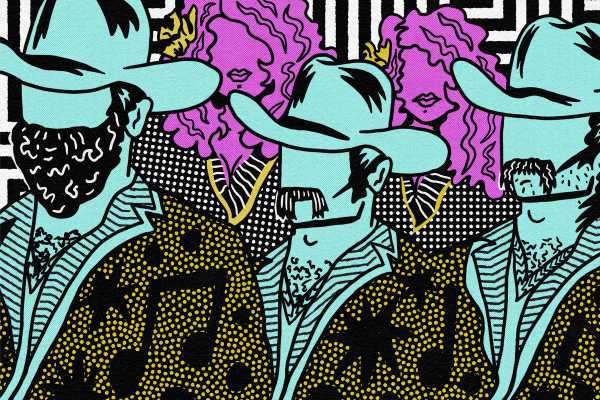
Data Drives Sameness
Watson described how the country radio charts, like Billboard’s Hot Country Songs list, which includes streaming, “have become incredibly homogenous, not just in gender but with songs that stay number one the entire year.” She sees the homogenization of music as being caused by data — a consequence of the fact that streaming, radio, and record companies can access more information about their listeners than ever, faster than ever.
“Now that everything’s digital, we have data every minute of every hour of every day,” Watson said. “In the past it was very manual, reported over phone or paper — that’s really slow.” On the broadcaster side, the data motivate snap business judgments: “If a particular style is really driving ratings of your service up, whether radio or streaming, you’ll want to continue to play that kind of artist, based on fear of loss of ratings.” On the label side, the data create an excuse for homogenization. “If artist X is doing really well with a particular style, or a particular production value, then a label might do the same thing with artist Y,” explained Watson.
These are not new strategies, of course; culture is always driven toward copycatting by money and the hope of a larger audience. But the difference is how fast the iterative loop happens, and how algorithmic recommendations intensify the effect across cultural areas: music, television, interior design, or even plastic surgery.
We thought the long tail of the internet would bring diversity; instead we got sameness and the perpetuation of the oldest biases, like gender discrimination. The best indicator of what gets recommended is what’s already popular, according to the investor Matthew Ball, a former head of strategy at Amazon Studios. “Netflix isn’t really trying to pick individual items from obscurity and get you to watch it,” Ball said. “The feedback mechanisms are reiterating a certain homogeneity of consumption.”
An Updated Definition of Monoculture for 2020
Instead of discrete, brand-name cultural artifacts, monoculture is now culture that appears increasingly similar to itself wherever you find it. It exists in the global morass of Marvel movies designed to sell equally well in China and the United States; the style of K-Pop, in music and performance, spreading outside of Korea; or the profusion of recognizably minimalist indie cafes from Australia to everywhere else. These are all forms of monoculture that don’t rely on an enforced, top-down sameness, but create sameness from the bottom up. Maybe the post-internet monoculture is now made up of what is aesthetically recognizable even if it is not familiar — we quickly feel we understand it even if we don’t know the name of the specific actor, musician, show, or director.
Instead of discrete, brand-name cultural artifacts, monoculture is now culture that appears increasingly similar to itself wherever you find it.
A monocultural product reinforces our established range of taste-signifiers rather than challenging them or adding something new. Is it better to choose between a few things that everyone knows, or between 100 things that share a fundamental similarity, algorithmically sorted into a you-may-also-like category? The latter may not be that much more authentic, original, or diverse than the former. In fact, it often feels oppressive, as if there isn’t much of a choice at all. By the metric of similarity, we have more monoculture than ever.
Streambait and Spotify-core
Each digital platform is its own monoculture, with a homogenized style optimized for the structure of the platform and the algorithms that serve its recommendations. There are monocultures of Tumblr, Instagram, YouTube, TikTok, and Twitter (see all the “RT this with the worst thing you ever ate for breakfast” tweets). The sameness creates an aura of communal recognizability. The writer Liz Pelly coined the term “streambait” in a 2018 essay to refer to “this idea of creating music that people will stream and continue to stream, similar to the concept of clickbait,” she told me in an interview.
A related label is “Spotify-core,” used by the New York Times journalist Jon Caramanica to describe a song by the virtual Instagram influencer Miquela. Miquela’s 2017 track “Not Mine” is characteristic of the style as it now stands: soft vocals, an airy backbeat like the echoes from a club, and slight acoustic touches. Pleasant, ignorable, and instantly forgettable — not great but not the kind of thing that would make you pause the stream.
Streambait’s stars range from pop favorites — Billie Eilish and Lana del Rey — to more indie streaming grist like Big Thief, Clairo, and Cuco, who have all made it to mainstream attention via the internet. Spotify’s narcotized Chill Hits playlist, with over 5.1 million followers, is the genre’s breeding ground.
Like airplay on a major radio station, when a song hits a big playlist, it gets popular, promotes the musician to new listeners, and makes money. “Labels have been incentivized to either make music that fits on playlists or prioritize music that works on these playlists,” Pelly said — adapting to the Spotify monoculture like a goldfish to a pond. Optimization comes at the expense of originality. According to Pelly, streambait “is similar to the way that clickbait has a negative impact on journalism, when editorial decisions are made based on what is popular.”
“There’s a negative impact on art when such a high value is placed on what is popular,” she said. “Popularity is not a good metric for deciding the value of art.”
Is What Is Popular Necessarily Good?
Relying on algorithms to dictate our culture means evaluating things on the basis of popularity, engagement, scale, and speed. Yet we already know that what is popular is not necessarily good, and what is good is not necessarily popular. On top of that, the data provided by Netflix and Spotify are biased, shaped by their proprietary algorithms, which are black boxes, not transparent and precise evaluations of human taste. With social and streaming media, there might be more ways around the gatekeepers of the past. But algorithms are the new gatekeepers. Their parameters are still set by a small group: not Hollywood producers, but white, male engineers and data scientists.
Relying on algorithms to dictate our culture means evaluating things on the basis of popularity, engagement, scale, and speed.
What gets surfaced is still a small subset of what exists, and it doesn’t get surfaced in a democratic or transparent way, as Galaxie 500’s Damon Krukowski discovered looking at his band’s Spotify account. Their volume of plays from “Spotify algorithmic playlists” has been slowly declining, but the platform gives no reason or explanation for the change. “Which leaves us, too, a passive participant in all this,” Krukowski wrote. Passivity is not a good quality for making or consuming art.
Mono-Monoculture
The critics giving Avengers and Game of Thrones the epitaph of Last Universal Content are wrong: Today’s form of monoculture is both larger in scale and less human, more mechanically automated, than ever before. Culture is now Big Data. Just what we have lost in the transition from human to machine tastemakers is still bearing out.
There seems to be more opportunity for diversity (anything can theoretically go viral) and yet the cultural artifacts that do become mainstream appear relentlessly optimized for the digital platforms of the attention economy. Take “Old Town Road,” for example. It’s a song by the creator of a popular Twitter account that was primed to spread on TikTok, then embraced as a meme, and then made even more famous by a preexisting country-music celebrity. The song itself is fine, but the most interesting thing about it is how it’s a product of the structures that now govern our digital culture.
Instead of worrying about the loss of monoculture, I’m more concerned that there isn’t enough room for products or projects (or even places) that are not memes, that aren’t pre-optimized for sharing or scaling. In the end I fall more on Scorsese’s side of the argument, though I wouldn’t wish for any more Scorsese: The non-homogenized alternatives to the mainstream become harder and harder to find. As we grow more accustomed to the algorithmic monoculture, allowing it to occupy our senses, we might lose our understanding of, or our taste for, anything else.
Lofi Monocultural Beats to Exist to
If you want a vision of the future of culture, imagine an infinite playlist of lofi hip hop radio – beats to study/relax to, in all media — forever. Picture the ambient-music YouTube channel’s aesthetic applied to everything else: anodyne, blameless, meaningless, boring, designed only to occupy time. Form will outweigh content’s authorship, originality, or artistry. The future will be to the present as TikTok is to prestige television.
Human™ Culture
Digital-platform companies seem to be realizing that they need to move away from totally automatic recommendations, or at least appear to do so. They are turning to human “curators” as a way to break from algorithmic sameness and demonstrate that there’s still a personal (that is to say monocultural) connection when consuming digital content. They are deploying humanity as branding.
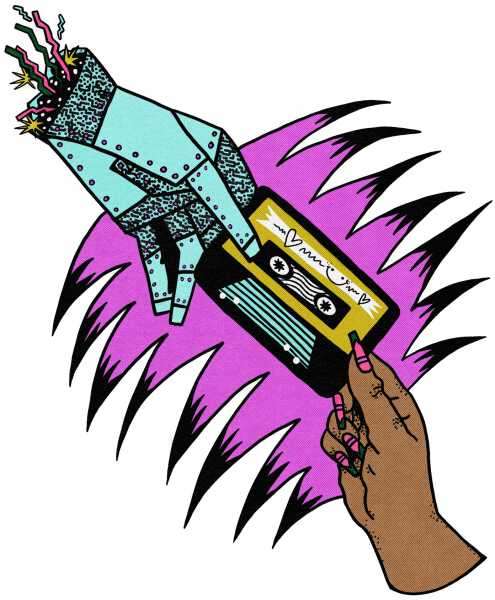
Earlier this year, Netflix began testing playlists curated by “experts on the company’s creative teams” with themes like “Artful Adventures” and “Critics Love These Shows.” Facebook is hiring curators — “seasoned journalists” — for its News Tab in order to fight misinformation. You shouldn’t let “computers decide what you want,” the CEO of Disney Bob Iger said during a Wall Street Journal technology conference. HBO’s latest advertising campaign is titled “Recommended by Humans,” featuring human fans explaining why they like the human HBO shows that they have watched with their human eyes. Preference appears to be shifting away from the algorithmic, similar to how consumers might prize handmade goods over mass-manufactured ones.
These are attempts to reassure us that our culture is not yet fully robotic, that it is still meaningful. In the end, we shouldn’t just want to consume things that are fully engineered to attract our attention, which gets converted into money. We should actively seek out elements of messiness and magic, serendipity that pure data can’t provide. As HBO’s head of programming Casey Bloys told the Los Angeles Times: “Our shows will never exist just to exist; they all have something to say about the world.”
Bloys gave the example of Succession: The show was motivated by his own personal desire to see a resonant story about family, not some abstract, algorithmic calculation. He made the decision not to hire established celebrity actors for the show, which would mathematically increase its chances of attention, but to start from scratch with lesser-known talent: “At HBO, we make our own stars,” Bloys said.
The result is a successful example of human taste, something that we didn’t quite recognize and didn’t yet know we wanted (the opposite of how Netflix claimed in 2013 that it made House of Cards because of Big Data). Succession was an unhomogenized surprise that could be on its way to becoming new monoculture.
The Value of Surprise
Art’s deepest impact comes when it is least expected. In contrast, algorithmic recommendations lead us down a path of pleasant monotony: a looming monoculture of the similar. To resist it, we should embrace obscurity, difficulty, diversity, and strangeness as just as important as recognizability or universality.
These are the qualities that need most to be preserved against the frictionless consumption pushed by our automated feeds. Otherwise, any new, surprising content that enters the machine of digital monoculture will quickly have its innovative quirks stripped and copied, scaled up and repeated until they become cliches. They will be incorporated into a constantly updated global homogeneity that possesses the sheen of familiarity but no substance beyond style.
III. RESISTING THE MONOCULTURE
Introspection
Reading the author Caleb Crain’s recent novel Overthrow, I was particularly struck by a single line: “It’s like there’s a sumptuary law against introspection,” the character Elspeth pronounces after getting badmouthed on the internet. (Sumptuary laws are rules governing consumption, often limiting what lower classes can buy or wear.) Elspeth considers how thinking too much, or being too self-aware, might be cast as an excessive, illegal luxury.
Overthrow is, in part, about the uncanniness of post-internet life, when you are never sure when you’re being surveilled and what some distant server might know about you, or which thoughts or desires could be subconscious digital implants rather than your own. The novel’s protagonists resist the numbing effects of automated surveillance capitalism through their participation in an Occupy-esque protest, deploying Tarot cards and (perhaps) gentle mind-reading powers to resist the invasive specter of technology.
The algorithm is a replacement for our internal monologues and our judgements about what we want to consume.
I called Crain to talk about what he meant by this antipathy of introspection. “We’re in this moment where just being alone and by yourself and having your own thoughts that maybe you don’t share is almost frowned upon,” he said. There is a pressure to make every statement as unambiguous as possible: to be a huge fan of the new thing. The monoculture actually dominates public discourse, an effect intensified by the media industry’s decline and the lack of opportunities for well-paid criticism, according to Crain: “Unless you’re weighing in on the big cultural product of the moment, who cares what you think?”
The algorithm is a replacement for our internal monologues and our judgements about what we want to consume. Streaming’s passivity is different from linear TV, but in the end, it’s still passive. In a 2017 interview, the author, critic, and former Twitter celebrity Teju Cole likewise described social media as “a monster that feeds on noise” that “could not allow for a kind of distance, silence, refocusing of energies.” In a recent essay, Zadie Smith critiqued the “digital maw” that digests our language and spits it back at us, warped and commodified. For Smith, the excess of data forms a “shadow text” that replaces human culture with its uncanny facsimile.
Under these conditions, pursuing obscurity instead of attempting to participate in the monoculture becomes a defense mechanism and a survival strategy.
“I personally like the idea of hiding out, finding your own rabbit hole. I think I believe in making yourself irrelevant as an almost spiritual quest,” Crain told me. “Every time you open a book that nobody has recommended, you hope that you’ll find that secret voice that you needed to hear, that nobody could have told you was there.”
The magic is still in what the algorithm can’t surface, what data doesn’t touch — the introspective space in which you can develop your own opinions in private before making them public commodities and measuring them against the mainstream. Because once something enters the cycle of digital monoculture, its essence will, inevitably, be lost. So enjoy it while you can.
Bathroom Rembrandt
The desire for monoculture is understandable, though its disappearance is more perception than reality. Art is communal. We want to connect with other people over experiences that we share in common. But just as important is being alone, having a unique encounter — not seamlessly recommended or autoplayed — with something that another person created, and then gauging your deepest emotional response. The internet makes this more difficult, even as it makes sharing (or superficially liking) things easier and faster.
I often think of something the New Yorker’s longtime art critic Peter Schjeldahl said in a 2007 interview, a kind of manifesto for his criticism: “Give me a Rembrandt in a subway station toilet and a flashlight and I’m happy.” I take this to mean that the delivery mechanism of culture doesn’t have to be slick and seamless, nor does the way we consume it. The masterpiece doesn’t have to be shown off in a white-walled gallery and the viewer handed an espresso in a porcelain cup. It is worth a struggle to access, Schjeldahl argued; perhaps the struggle, the precarious intimacy of the experience, makes worthwhile art shine even more.
Rembrandt died in 1669, impoverished, in obscurity. And yet it is his late work, the deeply luminous portraits with scumbled brushstrokes, completely unpopular with his contemporaries, that strikes us most today. It took centuries for the paintings to become mainstream. The process was neither fast nor convenient, though it may now seem like a foregone conclusion.
Digital media, by contrast, prioritizes immediate engagement over the slow blooming of art. I get the sense that today’s algorithms would prioritize Deep Dream patterns — a memetic style without content — over late Rembrandt. The danger of prioritizing the monoculture is that we might not get as many Rembrandts in the future.
Watching Separately, Together
Instead of taking the place of linear television’s monoculture, the streaming-media internet can, at its best, be more like a digital permaculture: an ecosystem of smaller platforms and bigger; smaller projects and bigger; and artists both famous and not, all sustaining each other. The anxiety comes more from the ways that we find and share the things that we’re interested in.
At a moment when culture is indeed more “mass” than ever, accepting the freedom of going outside of what’s already popular can be scary. But if we don’t take the risk, the other option is boredom, the boredom of having too much content and none of it interesting enough.
Thanks to Till Janczukowicz of Idagio, Penelope Bartlett of Criterion, David Turner, Samantha Culp, Kelly Loudenberg, Nick Seaver, and Erika Hapke for other conversations that informed this piece.
Sourse: vox.com






